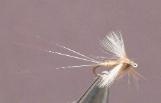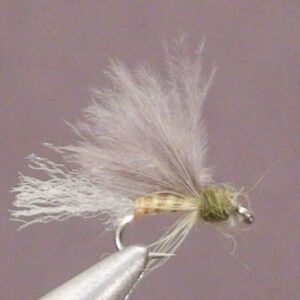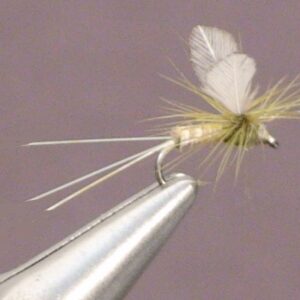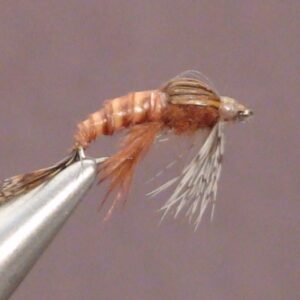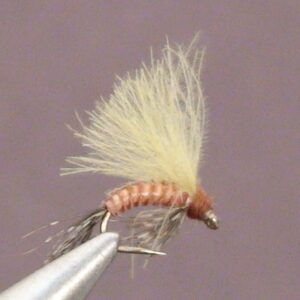Hook Size: 16/18
The Perfect Fly Pale Morning Dun Spinner is a imitation of the spinner stage of life of the mayfly. Once the dun reaches the banks, trees or bushes, it molts into a spinner, or the sexually mature adult. The males and females return to the water and mate in mid air, and eventually fall dead on the surface of the water where trout can easily dine on them. It should be fished on the surface and treated with floatant.
Look for the spinners to fall over ripples upstream from the calmer water from which
they emerged. Warm, calm days are the best for large spinner falls. Spinners fall both
in the mornings and evenings. Generally, the spinner falls occur in the mornings during
warmer weather. After they mate over water, the males fall to the water and die. Later,
the females deposit their eggs by flying over the riffles and dipping slightly into the
water. They then fall spent and die.
Spinners can be difficult to see although the insects may cover the water. If you are not
familiar with the spinner fall, it is possible to be on the water and not even know it is
happening. The trout tend to sip the spinners and although you may see the rises you
may not have a clue as to what the fish are eating. They are very difficult to see even
when there are a lot of them on the water, especially during the low light conditions they
occur under. A skim net will quickly tell you if they are on the water and is the best way
to determine if the spinner fall is occurring. Look for areas where the spinners
congregate in such as slow water below riffles, seams of current and eddies.
Presentation:
We prefer the Perfect Fly spent wing imitations of the PMD spinner. Usually, the females
actually touch the water to deposit their eggs but sometimes they drop them from slightly
above the water. The trout may take them while they are depositing the eggs but they are
more likely to eat them after they die and fall spent into the water. The females die as
soon as they have deposited their eggs.
It is much easier for the trout to position themselves downstream from the area they
deposit their eggs to eat the spinners than it is to chase them around the faster water
where they deposit their eggs.
Use a very light tippet and make an upstream or downstream approach that best
presents a drag free presentation for the type water you are fishing. Generally, a down
stream presentation is best for smooth, calmer water and an upstream presentation is
best for streams consisting mainly of pocket water.
In rough water, you will want to concentrate on the areas the spinners would congregate
in, such as eddies, the ends of riffles and runs, and the heads of pools. It’s much easier
for the trout to pick off the helpless spinners where they are concentrated in the slower
moving water than the faster water.
Copyright James Marsh 2013
